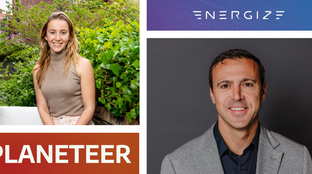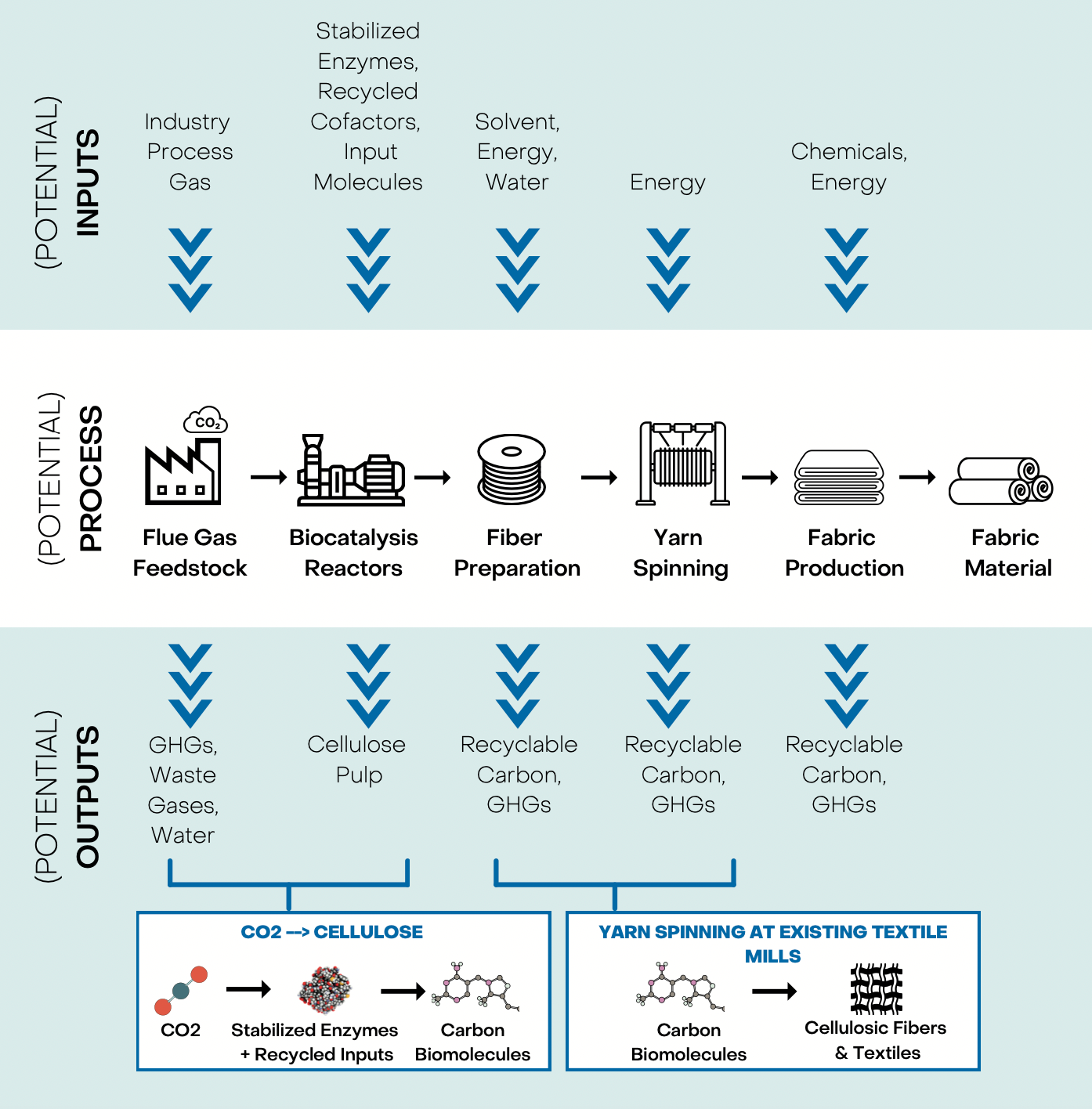
🌎 Two climate investors on raising in today's tough market
Q&As with Sophie Purdom, who just closed first-time Planeteer Fund I, and John Tough, who recently closed Energize Capital's mega-fund Ventures Fund III
Why doesn’t technology mimic the alchemy of photosynthesis? That’s the question Neeka Mashouf has been asking since she was a teenager. Now the CEO of Rubi Laboratories, Mashouf wants to clean up the industrial sector and create processes that harness the powerful systems of the natural world to create a sustainable manufacturing ecosystem.
The California-based startup is starting with textiles to address the footprint of the $2.5T fashion industry, which accounts for ~10% of global CO2 emissions—more than aviation and shipping combined. [Read more about the industry’s footprint in our sustainable fashion deep dive]. Rubi's novel tech uses enzymes to generate the same type of chemical reactions that happen in photosynthesis in order to capture CO2 and transform it into cellulose fibers that can be made into garments.
We’ve spilled plenty of ink in this newsletter on carbon capture, but less on what happens after—particularly carbon-to-value. Rubi endeavors to repurpose CO2 emitted from manufacturing and convert the waste stream back into commodity inputs, all while avoiding the green premium.
Fast fashion decarbonization
In the fashion industry value chain, 70% of emissions come from upstream activities and 30% from downstream. The majority of upstream emissions are generated from the fertilizers and chemicals used to cultivate and treat materials (e.g., cotton) and the energy needed to process fabrics and manufacture the garments themselves (e.g., spinning, weaving, and knitting). Downstream emissions result from the transportation and packaging involved in distribution, product usage itself (e.g., washing and drying), and end of life (e.g., incineration or landfills).
Fashion’s upstream emissions from processing and distribution are hardly unique to the industry alone—long-term pathways to decarbonization will rely on the broader energy (and vehicle) transition. In the meantime, Rubi aims to capture the CO2 from industrial processes and use it to make apparel inputs carbon-negative.
We sat down with CEO Neeka Mashouf to discuss the company’s novel enzymatic process, recent partnership with Walmart, and journey to commercial manufacturing scale.
What’s your background? How did it lead you to start Rubi?
My background is in materials engineering. When I was 15 years old, I published my first paper on artificial photosynthesis at the Lawrence Berkeley National Lab here in the Bay Area, and that was an initial spark for me of using science to learn how natural systems work and how we can apply it to manufacturing, energy, and other major industries that are important for human prosperity.
I studied materials engineering and business at Berkeley. I worked on energy, solar and wind materials, batteries and supercapacitors, and how we can speed up this research using computation. For a few years I was in industry, but I really wanted to get back to science and research. So on the side of a full-time job in 2020, I found a public lab here in the Bay Area where anyone could go do wet lab research. I started developing the tech behind Rubi. My twin sister, Leila Mashouf, also has a very deep technical background, but more in the bioengineering space. She was most recently at Harvard Medical School and wanted to use that research to help solve the climate problem. We teamed up to start the company and we've been growing since then.
Describe your technology. What’s the high-level explanation of the steps between CO2 and a fabric?
The easiest way to think about it is we're mimicking what a tree does. A tree breathes in CO2 and then uses several enzymatic steps to turn that CO2 into cellulose, which then builds up its trunk and branches and leaves—its structural material. We mimic that with a fully enzymatic production system. There's no cells involved, no trees involved either.
It's not a fermentation system. It's a biochemical process. The enzymes grab onto CO2 as it comes into the system, and then, over several steps, it runs through reactions to turn the CO2 into a long carbon polymer. That's the cellulose pulp that we make.
So we're talking about a chemical reactor filled with enzymes on-site at a manufacturing facility taking in CO2 directly and transforming it into cellulose that then can be transported as a solid, which also helps logistically with carbon capture and utilization. The next step is just traditional textile production.
The pulp gets extruded into fibers, twisted into yarn, and woven or knit into a fabric. What we're making is the third-most popular category of textiles, after polyester and cotton, called man-made cellulosic fibers.
You might know it as Viscose, rayon, lyocell, Tencel. It’s in a really wide variety of products—tops, bottoms, sweaters, jeans. This family of textiles traditionally comes from trees, so it's responsible for ~150 million trees cut down every year for the textile industry. The end product today is biodegradable, and what we're making is identical.

Tell us more about the enzymes. Do they come directly from living organisms? What does it take to engineer a system built on enzymes and where has Rubi implemented innovative solutions?
We call it an enzymatic cascade. The first enzyme grabs onto the CO2 and converts it into an intermediate, which is then grabbed by the next enzyme that turns it into the next thing. For our minimum viable product (MVP) system, we've looked across all published literature and data on enzymes, and optimized a pathway across living organisms of the best enzymes that can do this. We've started with a naturally occurring enzymes strategy, and that's allowed us to move quickly, so that we can start testing our material. At the same time, we're engineering different parts of our system, different enzymes, to get improvements in various ways for industrial scale-up.
There are other industrial processes that use enzymes at a large scale, like wastewater treatment, high fructose corn syrup production, etc. Those are all pretty simple in their process and mostly used to break things down, like decomposing plant matter into sugar.
Our big innovations are in the enzymatic pathway, including how we smartly recycle intermediates and how we deliver energy into the system so that we can actually build up molecules. Those are technical breakthroughs that are important in making this happen and why it hasn't been done before.
On the reactor side, we’ve innovated the full reactor system design and tubing to maximize the efficiency of each of the enzyme reactions. Our reactor is affordable because the individual pieces are actually off-the-shelf.
How is that different from other processes designed to utilize captured CO2?
Compared with a chemical catalysis system, which other carbon capture tech uses, enzymes are incredibly specific. They've evolved to do just their one function, which allows us to turn all of the carbon coming in into the end product that we want. If you're using just an electrode and trying to capture CO2 that way, you get a lot of byproducts because it's not specific to the one intended reaction. If you're running a fermentation system using microbes like yeast or bacteria, you get a lot of waste products because you're basically trying to domesticate a microbe—getting it to take in either CO2 or glucose as the carbon source and then turning that into sustainable aviation fuel, for example. But there's thousands or even millions of reactions happening in the cell that you don't want. In a microbial scenario, typically ~30% max of what you're putting in gets turned into your end product. There's a ceiling to what you can do to engineer a microbe to make as much product as you want, because it still needs to survive, grow, and make its cell wall, membrane, and other parts of the cell using those carbon materials. So you get a lot of waste.
Now imagine that you're just taking the factory line in that cell that contains the chemical reactions to get you the product you want. We're isolating that, putting it in a reactor, and just running a chemical process. That makes it more efficient, more affordable, cost-effective, and scalable.
Who are your target customers?
Really any manufacturing plant that has a CO2 stream, which is a lot of them, are perfect fits for our system. It’s a win-win for us to co-locate and do point-source capture with manufacturers. We get paid for a carbon removal service, and they can achieve their decarbonization goals. At this point, we want to scale as fast as possible. We think the best way to do that is delivering a product into the apparel supply chain—a yarn, made through our process, that can then go into manufacturers weaving or knitting and make end garments. So it’s kind of a two-sided revenue and customer model.
Tell us about your partnerships and the progress you’ve made so far with pilot projects.
Earlier, this year, we announced several of our major brand partnerships with companies like H&M, Reformation, Ganni, etc. Those pilots cover the end points of our process—making cellulose from CO2, testing it in a fiber yarn and textile, proving the properties in textile applications, and then making prototype garments and moving forward into larger commercial agreements at the end of that pilot. Last month, we announced a partnership on the manufacturer side with Walmart, and we have pilots in the works with other large manufacturers encompassing the full scope of the process. We’ll test the carbon capture and conversion piece and then also production, testing the end cellulose in industrial applications. These partners are either broad manufacturers, like food and beverage, or they’re textile mills where we can test both on-site.
At this point, we’ve de-risked the science and tech substantially. We've tested the end-to-end CO2-to-cellulose process. We've scaled it up in our small pilot-scale facility here in San Francisco, and we've been able to test the properties of the cellulose, the fiber, the yarns, and the textiles. We've just started our textile testing and production for a wide variety of different applications, so athletic wear, more casual wear, more mass market—all of those things are coming next in these brand pilots to prove the broad scope of what we're making.
Why did you start with fashion?
It was definitely a strategic business decision to start in the apparel industry with this tech. We had an insider scoop on that, because we grew up in the fashion industry—maybe it's not quite as well known in the science space. Even though fashion is the third-most CO2 polluting supply chain on the planet, it does not get the attention it needs.
The reason it's such a great initial market is because fashion has been the first-mover in at least trying to adopt sustainable new materials, because their consumers are heavily demanding change and sustainability. Over the last five years, individuals are more aware of the climate issue, and fashion is always in the crosshairs of people's beliefs and values. Even if it's led to greenwashing because there are no solutions that they can actually adopt, the fashion industry has at least tried to adopt things and pay more. They're willing to try new things, whereas in other industries selling commodities, it’s a much harder battle.
How does Rubi’s cellulose product compete on cost? Is there still a green premium these partner companies are willing to pay?
I think our partnership with Walmart signifies that we’re trying to make our technology available and accessible to everyone—no green premium needed.
Enzymatic systems today at scale, like high fructose corn syrup and wastewater treatment, are successful because they can be affordable per unit. Enzymes are really efficient and they can be reused over long lifetimes. As we get to our first demo-scale plant, we actually expect to be at price parity with standard textiles on the market today. That's a unique starting principle we used to develop this tech and why we took this different approach. Other technological approaches, fermentation, for example, are often much more expensive and require a lot of capital to scale. We didn't want any of that baggage, so we developed the tech to make sure that it could be affordable and at price parity as soon as we get to our first industry scale.
What are the key barriers to scaling and the next steps for the company on the journey to commercialization?
The scale that we're trying to get to is massive. One challenge that we've run into is that the minimum amounts for major textile production facilities are pretty limiting.
Earlier this year, we were producing on the order of grams, and that really limited us to academic partners. Now we're on the order of dozens of kilograms. Most of the large textile manufacturers have R&D facilities that can run these processes, like making sample batches of yarn and textiles, and the kilogram level is enough for that. For maybe less innovative, maybe more mid-sized textile players that just have the massive facilities, we’re talking about 100 tons or so to do a run.
The next step is making a lot more cellulose product that we can use to do the next round of testing in the industry. We do get revenue through pilots or commercial contracts, but to get up to the gigaton-scale carbon impact that we want, each of these incremental growth stages help us unlock the next, larger production scale and integrate into industry. Our tech team is working on scaling from the pilot-scale production system that we've built here to an on-site demo-scale system at a manufacturing plant.
How will you fund that demo plant?
These pilots help establish a proof-point, and we're seeing a lot of interest from strategic partners in funding initial facilities or the scale-up and development.
It means so much to have a customer want to invest to help scale up something like this. On the financing side, I think there is a really big gap in the market for FOAK facilities.
It's something we've seen our customers interested in, we've seen government grants, and we're looking at some of these firms that may specialize in FOAK financing. Those are all good options, but definitely there's a big gap there that, for this whole industry to rise up, needs to be filled.
How are you thinking about scaling beyond fashion?
We're building this platform for turning CO2-into-X with an enzymatic system. To move from cellulose to proteins, for example, we can still use the reactor developments, the core platform developments, but it takes some tweaking of the end enzymes to get to a different product.
When you look at how products are made today—textiles, food, building materials, packaging—it’s through agriculture or other carbon-intensive industrial production methods, where CO2 emissions are inextricably linked to the way that things are manufactured.
Beyond just carbon capture and utilization, what we aim to do is develop a new way of manufacturing things that can be carbon-negative and water- and land-neutral. We call it symbiotic manufacturing.
We're not just trying to find a use for CO2. We need to reinvent the way that things are manufactured and make them in a symbiotic way that can be planet-positive. When we talk about the impact, it's not just how much carbon we’re sequestering in the material. It's also that we're avoiding the emissions of the traditional manufacturing process of making that T-shirt. We eliminate the CO2 footprint from growing and processing cotton, make the same material, and sequester carbon in the process.
That sounds almost too good to be true. Why hasn’t this been tried before?
That's funny, because it's so hard. We’ve been focused on how we can break this down into the MVP steps of each stage of scale-up and prove a proof of concept before everything is perfected. Making this system really efficient in an industrial setting is the next step for us.
We've run through the whole CO2-to-cellulose process and done it successfully. We’ve made yarn and tested it in textile settings. Next we’re working towards getting to the right efficiency and cost factors at the demo scale to get to price parity.
All of that is still part of R&D, and we have an amazing team coming from biotech, large-scale commercial chemical engineering plants, and textiles to help us get there.

Q&As with Sophie Purdom, who just closed first-time Planeteer Fund I, and John Tough, who recently closed Energize Capital's mega-fund Ventures Fund III

A Q&A with Precursor's David Yeh and Mark1's Julian Ryba-White, new strategic partners in the ecosystem

A Q&A with the DOE LPO director Jigar Shah and Solugen CEO Gaurab Chakrabarti